Shuang Qiu
University of Michigan, Ann Arbor
USIM and U0: A Vision-Language-Action Dataset and Model for General Underwater Robots
Oct 09, 2025
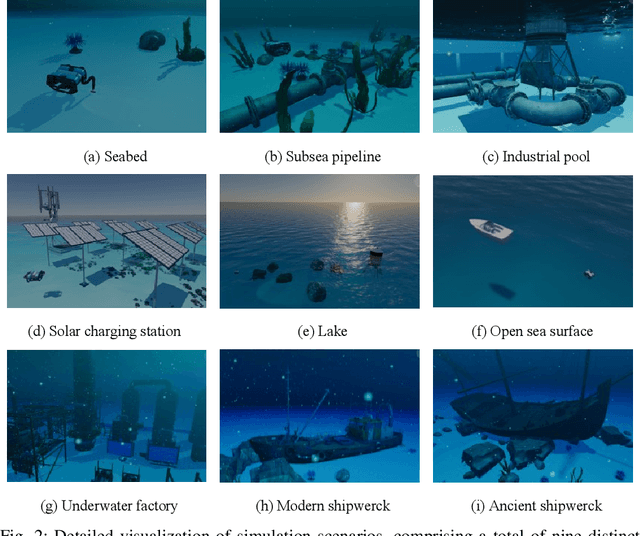


Abstract:Underwater environments present unique challenges for robotic operation, including complex hydrodynamics, limited visibility, and constrained communication. Although data-driven approaches have advanced embodied intelligence in terrestrial robots and enabled task-specific autonomous underwater robots, developing underwater intelligence capable of autonomously performing multiple tasks remains highly challenging, as large-scale, high-quality underwater datasets are still scarce. To address these limitations, we introduce USIM, a simulation-based multi-task Vision-Language-Action (VLA) dataset for underwater robots. USIM comprises over 561K frames from 1,852 trajectories, totaling approximately 15.6 hours of BlueROV2 interactions across 20 tasks in 9 diverse scenarios, ranging from visual navigation to mobile manipulation. Building upon this dataset, we propose U0, a VLA model for general underwater robots, which integrates binocular vision and other sensor modalities through multimodal fusion, and further incorporates a convolution-attention-based perception focus enhancement module (CAP) to improve spatial understanding and mobile manipulation. Across tasks such as inspection, obstacle avoidance, scanning, and dynamic tracking, the framework achieves a success rate of 80%, while in challenging mobile manipulation tasks, it reduces the distance to the target by 21.2% compared with baseline methods, demonstrating its effectiveness. USIM and U0 show that VLA models can be effectively applied to underwater robotic applications, providing a foundation for scalable dataset construction, improved task autonomy, and the practical realization of intelligent general underwater robots.
LatticeWorld: A Multimodal Large Language Model-Empowered Framework for Interactive Complex World Generation
Sep 05, 2025Abstract:Recent research has been increasingly focusing on developing 3D world models that simulate complex real-world scenarios. World models have found broad applications across various domains, including embodied AI, autonomous driving, entertainment, etc. A more realistic simulation with accurate physics will effectively narrow the sim-to-real gap and allow us to gather rich information about the real world conveniently. While traditional manual modeling has enabled the creation of virtual 3D scenes, modern approaches have leveraged advanced machine learning algorithms for 3D world generation, with most recent advances focusing on generative methods that can create virtual worlds based on user instructions. This work explores such a research direction by proposing LatticeWorld, a simple yet effective 3D world generation framework that streamlines the industrial production pipeline of 3D environments. LatticeWorld leverages lightweight LLMs (LLaMA-2-7B) alongside the industry-grade rendering engine (e.g., Unreal Engine 5) to generate a dynamic environment. Our proposed framework accepts textual descriptions and visual instructions as multimodal inputs and creates large-scale 3D interactive worlds with dynamic agents, featuring competitive multi-agent interaction, high-fidelity physics simulation, and real-time rendering. We conduct comprehensive experiments to evaluate LatticeWorld, showing that it achieves superior accuracy in scene layout generation and visual fidelity. Moreover, LatticeWorld achieves over a $90\times$ increase in industrial production efficiency while maintaining high creative quality compared with traditional manual production methods. Our demo video is available at https://youtu.be/8VWZXpERR18
Segment Policy Optimization: Effective Segment-Level Credit Assignment in RL for Large Language Models
May 29, 2025Abstract:Enhancing the reasoning capabilities of large language models effectively using reinforcement learning (RL) remains a crucial challenge. Existing approaches primarily adopt two contrasting advantage estimation granularities: Token-level methods (e.g., PPO) aim to provide the fine-grained advantage signals but suffer from inaccurate estimation due to difficulties in training an accurate critic model. On the other extreme, trajectory-level methods (e.g., GRPO) solely rely on a coarse-grained advantage signal from the final reward, leading to imprecise credit assignment. To address these limitations, we propose Segment Policy Optimization (SPO), a novel RL framework that leverages segment-level advantage estimation at an intermediate granularity, achieving a better balance by offering more precise credit assignment than trajectory-level methods and requiring fewer estimation points than token-level methods, enabling accurate advantage estimation based on Monte Carlo (MC) without a critic model. SPO features three components with novel strategies: (1) flexible segment partition; (2) accurate segment advantage estimation; and (3) policy optimization using segment advantages, including a novel probability-mask strategy. We further instantiate SPO for two specific scenarios: (1) SPO-chain for short chain-of-thought (CoT), featuring novel cutpoint-based partition and chain-based advantage estimation, achieving $6$-$12$ percentage point improvements in accuracy over PPO and GRPO on GSM8K. (2) SPO-tree for long CoT, featuring novel tree-based advantage estimation, which significantly reduces the cost of MC estimation, achieving $7$-$11$ percentage point improvements over GRPO on MATH500 under 2K and 4K context evaluation. We make our code publicly available at https://github.com/AIFrameResearch/SPO.
Revisiting Multi-Agent World Modeling from a Diffusion-Inspired Perspective
May 27, 2025



Abstract:World models have recently attracted growing interest in Multi-Agent Reinforcement Learning (MARL) due to their ability to improve sample efficiency for policy learning. However, accurately modeling environments in MARL is challenging due to the exponentially large joint action space and highly uncertain dynamics inherent in multi-agent systems. To address this, we reduce modeling complexity by shifting from jointly modeling the entire state-action transition dynamics to focusing on the state space alone at each timestep through sequential agent modeling. Specifically, our approach enables the model to progressively resolve uncertainty while capturing the structured dependencies among agents, providing a more accurate representation of how agents influence the state. Interestingly, this sequential revelation of agents' actions in a multi-agent system aligns with the reverse process in diffusion models--a class of powerful generative models known for their expressiveness and training stability compared to autoregressive or latent variable models. Leveraging this insight, we develop a flexible and robust world model for MARL using diffusion models. Our method, Diffusion-Inspired Multi-Agent world model (DIMA), achieves state-of-the-art performance across multiple multi-agent control benchmarks, significantly outperforming prior world models in terms of final return and sample efficiency, including MAMuJoCo and Bi-DexHands. DIMA establishes a new paradigm for constructing multi-agent world models, advancing the frontier of MARL research.
A novel gesture interaction control method for rehabilitation lower extremity exoskeleton
Apr 02, 2025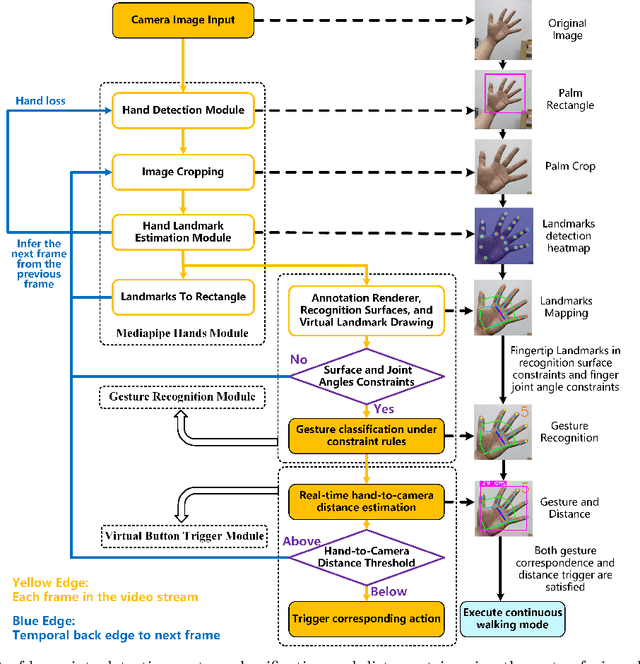
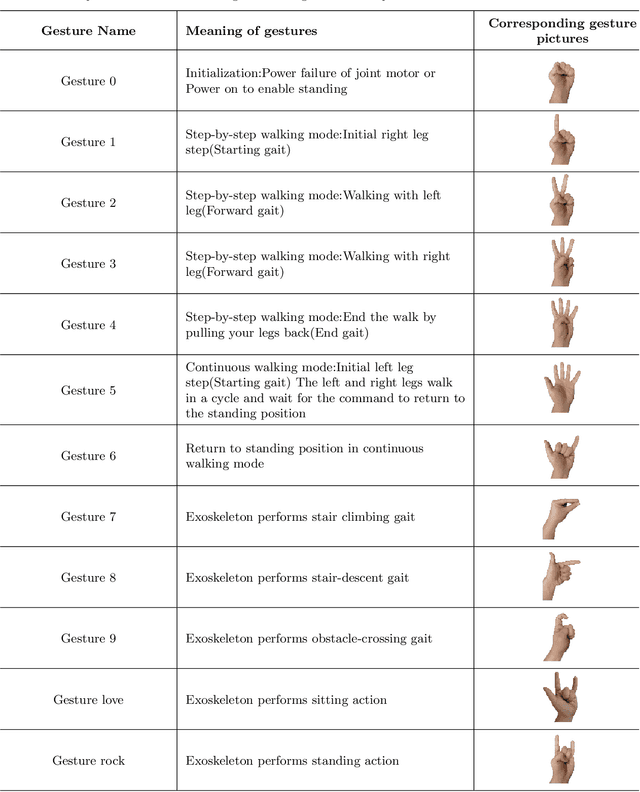
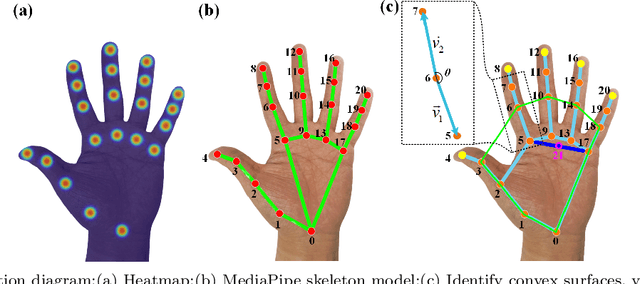
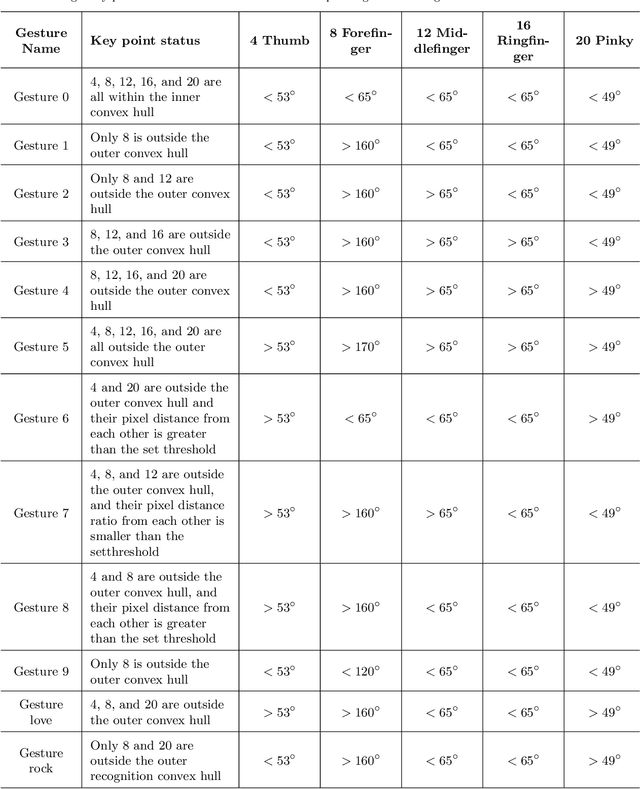
Abstract:With the rapid development of Rehabilitation Lower Extremity Robotic Exoskeletons (RLEEX) technology, significant advancements have been made in Human-Robot Interaction (HRI) methods. These include traditional physical HRI methods that are easily recognizable and various bio-electrical signal-based HRI methods that can visualize and predict actions. However, most of these HRI methods are contact-based, facing challenges such as operational complexity, sensitivity to interference, risks associated with implantable devices, and, most importantly, limitations in comfort. These challenges render the interaction less intuitive and natural, which can negatively impact patient motivation for rehabilitation. To address these issues, this paper proposes a novel non-contact gesture interaction control method for RLEEX, based on RGB monocular camera depth estimation. This method integrates three key steps: detecting keypoints, recognizing gestures, and assessing distance, thereby applying gesture information and augmented reality triggering technology to control gait movements of RLEEX. Results indicate that this approach provides a feasible solution to the problems of poor comfort, low reliability, and high latency in HRI for RLEEX platforms. Specifically, it achieves a gesture-controlled exoskeleton motion accuracy of 94.11\% and an average system response time of 0.615 seconds through non-contact HRI. The proposed non-contact HRI method represents a pioneering advancement in control interactions for RLEEX, paving the way for further exploration and development in this field.
Integrating Language-Image Prior into EEG Decoding for Cross-Task Zero-Calibration RSVP-BCI
Jan 06, 2025



Abstract:Rapid Serial Visual Presentation (RSVP)-based Brain-Computer Interface (BCI) is an effective technology used for information detection by detecting Event-Related Potentials (ERPs). The current RSVP decoding methods can perform well in decoding EEG signals within a single RSVP task, but their decoding performance significantly decreases when directly applied to different RSVP tasks without calibration data from the new tasks. This limits the rapid and efficient deployment of RSVP-BCI systems for detecting different categories of targets in various scenarios. To overcome this limitation, this study aims to enhance the cross-task zero-calibration RSVP decoding performance. First, we design three distinct RSVP tasks for target image retrieval and build an open-source dataset containing EEG signals and corresponding stimulus images. Then we propose an EEG with Language-Image Prior fusion Transformer (ELIPformer) for cross-task zero-calibration RSVP decoding. Specifically, we propose a prompt encoder based on the language-image pre-trained model to extract language-image features from task-specific prompts and stimulus images as prior knowledge for enhancing EEG decoding. A cross bidirectional attention mechanism is also adopted to facilitate the effective feature fusion and alignment between the EEG and language-image features. Extensive experiments demonstrate that the proposed model achieves superior performance in cross-task zero-calibration RSVP decoding, which promotes the RSVP-BCI system from research to practical application.
Forward KL Regularized Preference Optimization for Aligning Diffusion Policies
Sep 09, 2024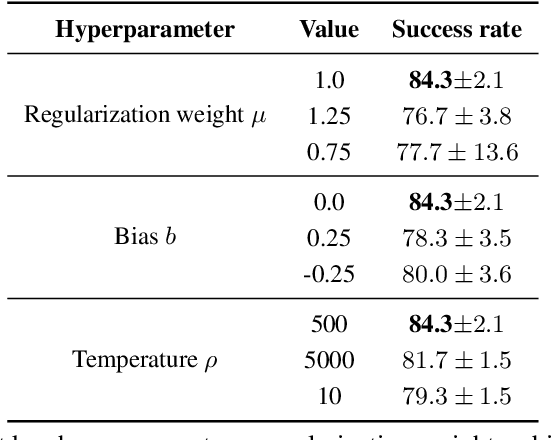
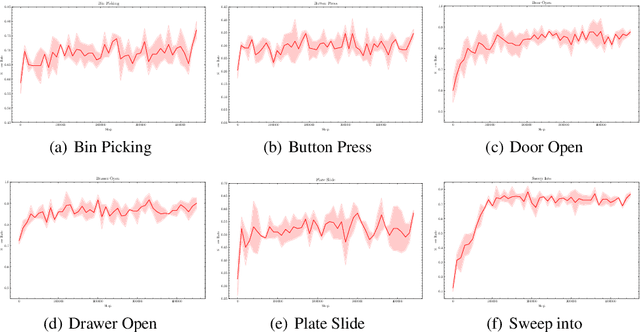
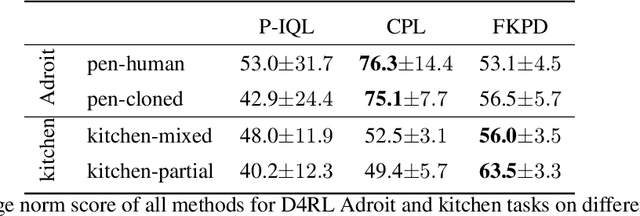
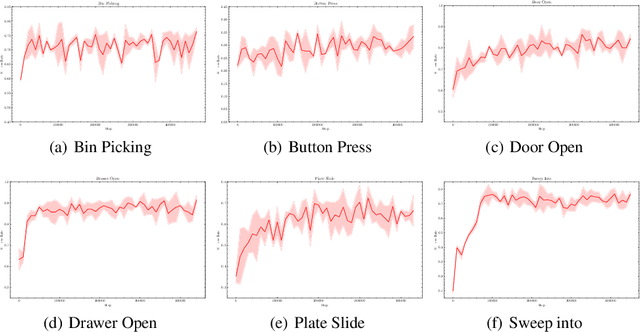
Abstract:Diffusion models have achieved remarkable success in sequential decision-making by leveraging the highly expressive model capabilities in policy learning. A central problem for learning diffusion policies is to align the policy output with human intents in various tasks. To achieve this, previous methods conduct return-conditioned policy generation or Reinforcement Learning (RL)-based policy optimization, while they both rely on pre-defined reward functions. In this work, we propose a novel framework, Forward KL regularized Preference optimization for aligning Diffusion policies, to align the diffusion policy with preferences directly. We first train a diffusion policy from the offline dataset without considering the preference, and then align the policy to the preference data via direct preference optimization. During the alignment phase, we formulate direct preference learning in a diffusion policy, where the forward KL regularization is employed in preference optimization to avoid generating out-of-distribution actions. We conduct extensive experiments for MetaWorld manipulation and D4RL tasks. The results show our method exhibits superior alignment with preferences and outperforms previous state-of-the-art algorithms.
Traversing Pareto Optimal Policies: Provably Efficient Multi-Objective Reinforcement Learning
Jul 24, 2024



Abstract:This paper investigates multi-objective reinforcement learning (MORL), which focuses on learning Pareto optimal policies in the presence of multiple reward functions. Despite MORL's significant empirical success, there is still a lack of satisfactory understanding of various MORL optimization targets and efficient learning algorithms. Our work offers a systematic analysis of several optimization targets to assess their abilities to find all Pareto optimal policies and controllability over learned policies by the preferences for different objectives. We then identify Tchebycheff scalarization as a favorable scalarization method for MORL. Considering the non-smoothness of Tchebycheff scalarization, we reformulate its minimization problem into a new min-max-max optimization problem. Then, for the stochastic policy class, we propose efficient algorithms using this reformulation to learn Pareto optimal policies. We first propose an online UCB-based algorithm to achieve an $\varepsilon$ learning error with an $\tilde{\mathcal{O}}(\varepsilon^{-2})$ sample complexity for a single given preference. To further reduce the cost of environment exploration under different preferences, we propose a preference-free framework that first explores the environment without pre-defined preferences and then generates solutions for any number of preferences. We prove that it only requires an $\tilde{\mathcal{O}}(\varepsilon^{-2})$ exploration complexity in the exploration phase and demands no additional exploration afterward. Lastly, we analyze the smooth Tchebycheff scalarization, an extension of Tchebycheff scalarization, which is proved to be more advantageous in distinguishing the Pareto optimal policies from other weakly Pareto optimal policies based on entry values of preference vectors. Furthermore, we extend our algorithms and theoretical analysis to accommodate this optimization target.
Pessimism Meets Risk: Risk-Sensitive Offline Reinforcement Learning
Jul 10, 2024
Abstract:We study risk-sensitive reinforcement learning (RL), a crucial field due to its ability to enhance decision-making in scenarios where it is essential to manage uncertainty and minimize potential adverse outcomes. Particularly, our work focuses on applying the entropic risk measure to RL problems. While existing literature primarily investigates the online setting, there remains a large gap in understanding how to efficiently derive a near-optimal policy based on this risk measure using only a pre-collected dataset. We center on the linear Markov Decision Process (MDP) setting, a well-regarded theoretical framework that has yet to be examined from a risk-sensitive standpoint. In response, we introduce two provably sample-efficient algorithms. We begin by presenting a risk-sensitive pessimistic value iteration algorithm, offering a tight analysis by leveraging the structure of the risk-sensitive performance measure. To further improve the obtained bounds, we propose another pessimistic algorithm that utilizes variance information and reference-advantage decomposition, effectively improving both the dependence on the space dimension $d$ and the risk-sensitivity factor. To the best of our knowledge, we obtain the first provably efficient risk-sensitive offline RL algorithms.
Human-like object concept representations emerge naturally in multimodal large language models
Jul 01, 2024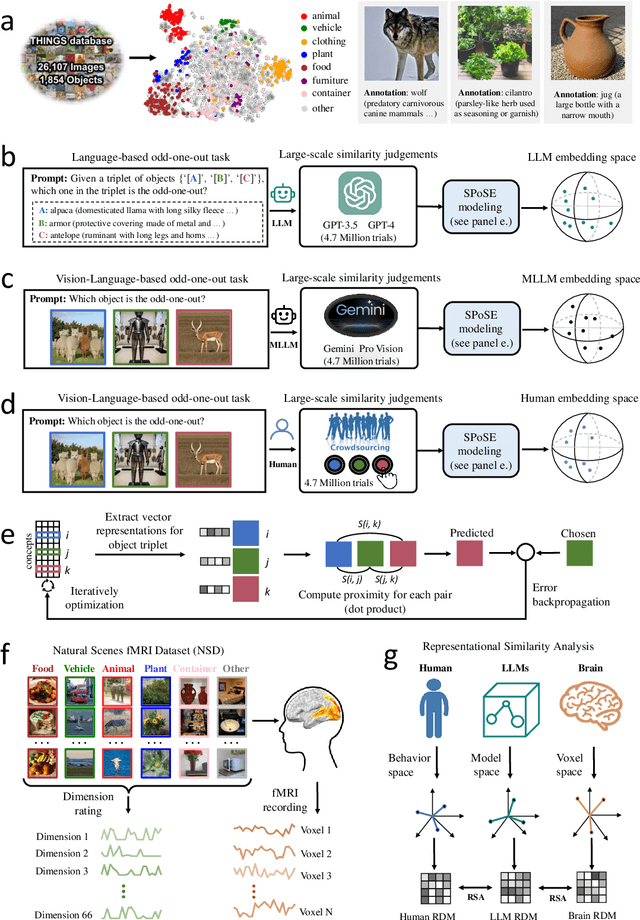
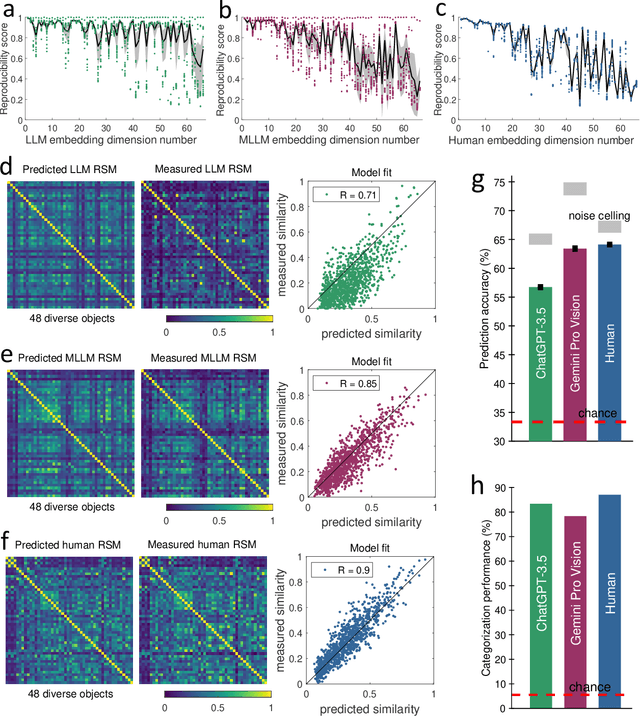
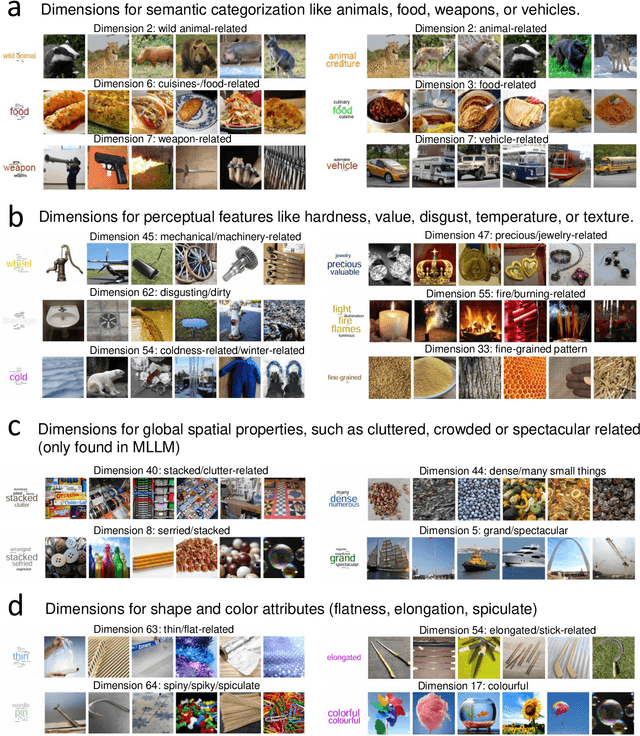
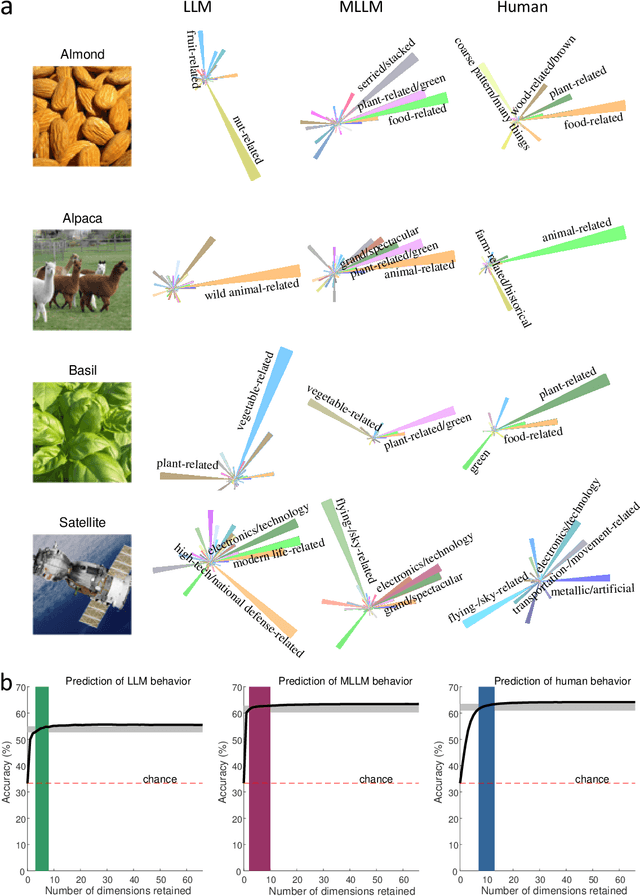
Abstract:The conceptualization and categorization of natural objects in the human mind have long intrigued cognitive scientists and neuroscientists, offering crucial insights into human perception and cognition. Recently, the rapid development of Large Language Models (LLMs) has raised the attractive question of whether these models can also develop human-like object representations through exposure to vast amounts of linguistic and multimodal data. In this study, we combined behavioral and neuroimaging analysis methods to uncover how the object concept representations in LLMs correlate with those of humans. By collecting large-scale datasets of 4.7 million triplet judgments from LLM and Multimodal LLM (MLLM), we were able to derive low-dimensional embeddings that capture the underlying similarity structure of 1,854 natural objects. The resulting 66-dimensional embeddings were found to be highly stable and predictive, and exhibited semantic clustering akin to human mental representations. Interestingly, the interpretability of the dimensions underlying these embeddings suggests that LLM and MLLM have developed human-like conceptual representations of natural objects. Further analysis demonstrated strong alignment between the identified model embeddings and neural activity patterns in many functionally defined brain ROIs (e.g., EBA, PPA, RSC and FFA). This provides compelling evidence that the object representations in LLMs, while not identical to those in the human, share fundamental commonalities that reflect key schemas of human conceptual knowledge. This study advances our understanding of machine intelligence and informs the development of more human-like artificial cognitive systems.
 Add to Chrome
Add to Chrome Add to Firefox
Add to Firefox Add to Edge
Add to Edge